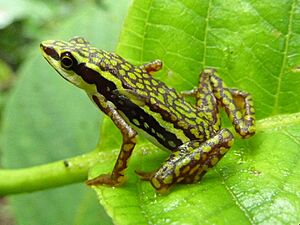Rio Faisanes stubfoot toad facts for kids
Quick facts for kids Rio Faisanes stubfoot toad |
|
|---|---|
 |
|
| Conservation status | |
| Scientific classification |
The Rio Faisanes stubfoot toad, also known as Atelopus coynei, is a special kind of toad. It belongs to the Bufonidae family, which includes many types of toads. This toad lives only in Ecuador, a country in South America. Its natural home is in warm, wet forests and near rivers. Sadly, this toad is in danger because its habitat (its home) is being lost.
Contents
About the Rio Faisanes Stubfoot Toad
The Rio Faisanes stubfoot toad has some unique features. You can tell it apart from other similar toads by the patterns on its belly. It also has thick, webbed skin on its first finger. Its back legs are quite long. When the toad sits with its legs out to the sides, its heels actually overlap! These special traits help scientists identify this particular toad.
Where It Lives and Its Home
The Rio Faisanes stubfoot toad used to live in many places across the northwestern Andes mountains in Ecuador. It was found in areas like Carchi, Imbabura, Pichincha, and Santo Domingo provinces. These toads prefer to live along the banks of streams in both old and new mountain forests. They can be found at heights between 500 and 2,000 meters (about 1,640 to 6,560 feet) above sea level.
Today, this toad is much harder to find. It is currently known to live in only four separate spots in Carchi Province. Two of these places are in the Dracula Reserve, and another is near the Río Chinambi river.
These toads are active during the day, especially when it's raining. They like to be on the rocky banks of rivers and streams. At night, they rest on the leaves of plants growing near the water. They lay their eggs on rocks in flowing streams. The baby toads, called tadpoles, are typical for Atelopus toads. They stay attached to rocks in the water.
Why This Toad Needs Our Help
The Rio Faisanes stubfoot toad is in a lot of trouble. Scientists have listed it as a critically endangered animal. This means it is very close to disappearing forever. There are very few of these toads left in the wild. Their numbers keep going down because their home is being destroyed or damaged. This mainly happens because of farming activities that take over their forest habitat. Experts believe there are fewer than 250 adult toads left. Protecting their forests and rivers is very important to help them survive.
How It Got Its Name
This special toad was named after a scientist named Jerry Coyne. He is an evolutionary biologist. Back in the late 1970s, when he was a student, Jerry Coyne went on a trip to western Ecuador to look for frogs. He found the very first Atelopus coynei toad there. For many years, people thought this toad had gone extinct. But then, on February 7, 2012, a photographer named Andreas Kay saw and photographed one! This was exciting news, showing that the toad was still out there.


